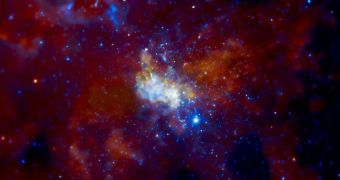In certain massive galaxies, including our own Milky Ways, the large black holes at their cores appear to be starving. That is to say, they no longer accumulate new matter in their accretion disks, from where they pass it on through the event horizon. In a new development, researchers using the NASA Chandra X-ray Observatory managed to peer into the heart of the galaxy, and determine the reason why this starvation occurred. The work is very important in astrophysics, as it could give experts hints as to what can stop a supermassive black hole from growing, Space reports.
Sagittarius A* is the name experts gave the dark structure at the core of the Milky Way. In the new investigation, the American space agency's telescope managed to get a glimpse of the galaxy's central areas. The observed region was about 120 light-years across, and also included the giant black hole. The formation is located relatively far away, some 26,000 light-years, and is estimated to be about four million times more massive than our Sun. Experts working with Chandra reported that they might have found the reason why these behemoths of the skies didn't consume as much matter as scientists expected them to.
The announcement was made on January 6 in Washington DC, at the 215th meeting of the American Astronomical Society (AAS). The researchers mentioned at the conference that black holes were not directly visible to outside observers. Their position can only be determined by examining the influence that they have on surrounding matter, as well as after the highly energetic radiation they emit upon accelerating surrounding matter into the accretion disk, before swallowing it up. The findings were presented by Harvard-Smithsonian Center for Astrophysics (CfA) Chandra team member Roman Shcherbakov.
Usually, black holes are in the habit of devouring stellar winds sent their way by neighboring stars. Generally, astrophysicists believe that the structures engulf about one percent of all this gas, but this does not appear to be the case in starving black holes, such as our own. Studies have determined that the structure only engulfs about 0.01 percent of stellar winds heading its way. “So the black hole really is starving,” Shcherbakov explained.
The team also found conductance to be a very important factor in the amount of “food” that the celestial bodies gobbled up. This factor had not been introduced in many computer models before, so scientists could not explain the discrepancies between the actual amounts of material gobbled up by black holes and the theorized ones. With conductance factored in, it became clear that pressure and heat traveled differently from the accretion disk to the event horizon, at times even allowing stellar winds to escape the gravitational pull of the black holes altogether.

 14 DAY TRIAL //
14 DAY TRIAL //